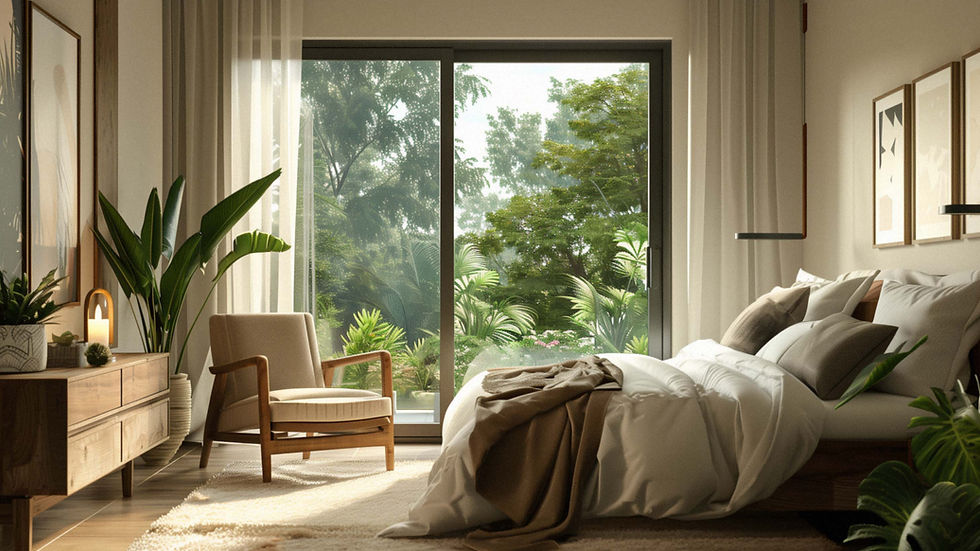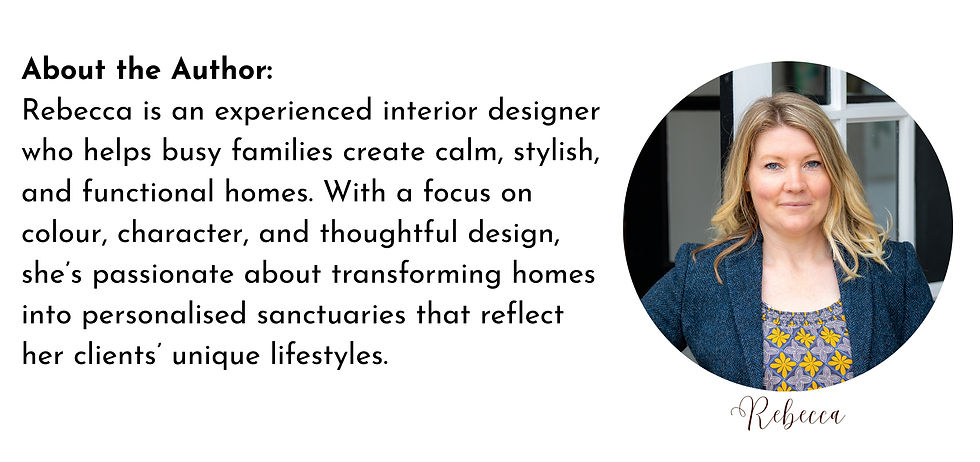Creating a Calming Home: A Sanctuary for Your Wellbeing
- Rebecca Bailey Price

- Jun 19
- 6 min read
Updated: Aug 11
Our homes are meant to be a place of calm and sanctuary. They should put us at ease so we can flourish in our lives. I believe that every home should work for its occupants.
The Pandemic effect on our homes
Since the pandemic, we have all spent more time at home than ever before. Many people now work remotely at least part of the week. As a result, our homes have had to transition into multifunctional spaces. No longer are they just places of relaxation; they are now hubs for work and family life.
Imagine being on an important call while having your young family at home. Perhaps you have a garden office where you welcome clients or colleagues. This new reality requires us to rethink how we utilize our home spaces.

With these changes, we must adapt our homes. We all know that panic when we suddenly realize someone is coming over, and our house is a mess. It can be embarrassing when a colleague sees an unfinished DIY project, or we must blur backgrounds during online calls to hide clutter. These situations can lead to feelings of stress, embarrassment, or even depression. The impact of our home environment is significant.
According to YouGov, "54% of UK homeowners say clutter negatively affects their mood."
Our homes and environments have a direct effect on our mental clarity. This is crucial for maintaining a happy and healthy life. So, how do we create that calming home atmosphere?
Tips for a Calming Home Environment
I want to share these tips because I believe our homes should serve as sanctuaries. They should feel as good as they look. You might be surprised to learn that even small design tweaks can have a measurable effect on your wellbeing. “93% of people say having a tidy, well-designed space helps them feel calmer and more in control.” This is supported by research from the National Association of Productivity & Organizing Professionals.
The Science of Space and Wellbeing
Numerous scientific studies have proven that our environment directly impacts our nervous system. Walking into a messy or dark space can lead to feelings of stress and unhappiness. These experiences can create long-term effects, leaving us feeling anxious and depressed.
For example, "People who describe their homes as cluttered have higher levels of cortisol," the stress hormone, throughout the day, as reported by the UCLA Center on Everyday Lives of Families. This elevated stress can affect various aspects of our lives, such as work performance and relationships.
Research indicates that natural light can significantly improve our mood and reduce stress. It has been shown to increase productivity by up to 40% according to the Harvard Business Review and the Future Workplace Survey. Poor lighting, on the other hand, is linked to increased symptoms of depression and disrupted sleep patterns, as found in the Journal of Environmental Psychology.
Having a well-designed space that meets your lifestyle needs can be a game changer after a busy or stressful day at work.
Imagine returning to a home that's cluttered and stressful. Negotiating clutter in hallways can add to feelings of anxiety. Conversely, envision coming home to a calm and comforting environment. You can take a moment to gather yourself, enjoy a drink, and discuss the day. Having a well-designed home that works with your lifestyle is essential.

Design Elements That Support Wellbeing
Light
Natural daylight can instantly improve a space's feel. Just think about how opening curtains can change the atmosphere in a dim room. Layering lighting is also vital. Use lamps, dimmable lights, and avoid harsh fluorescent lights. Warm white bulbs create a cozy ambiance compared to cold lights.
Colour
The impact of colour, pattern, and texture on our feelings is substantial. Different shades evoke different emotions. For example, green is calming and is often used backstage at events to help entertainers relax. It adheres to the idea of Interior Design for Wellbeing.
Beware of using energizing colours like orange in spaces meant for relaxation, such as bedrooms. Understanding colour psychology can dramatically influence how your home feels. Warm tones like peach, beige, and light terracotta promote a sense of cosiness, while blue-greens can reduce anxiety. [Source: University of Westminster study on colour and wellbeing].
Patterns and textures also play a role. Soft textures can enhance a feeling of comfort, while busy patterns may overwhelm some individuals. I suggest taking a quiz to discover your interior design style. I'm passionate about colour, which is one of the reasons clients choose to work with me.
For more on this, I offer Colour and pattern Workshops as well as consultations. Together, we can create a colour scheme that fits your vision and enhances your space.
Layout and Flow
A suitable layout is foundational in design. An incorrect layout makes a room dysfunctional. Avoid oversized furniture that obstructs movement. Ideally, you want to leave 60 to 90 cm between furniture for ease of movement. Good spatial planning is essential for a well-designed space, and it shouldn't be overlooked.
Decluttering and Storage
Clutter results from either too many belongings or insufficient storage. Many people struggle with both. "54% of UK homeowners say clutter negatively affects their mood," per YouGov. Everyone can benefit from a decluttering process to prioritize items that truly add value or joy to their lives.
Adequate storage solutions are crucial. You need easy access to items that work with your home's layout. I'm a big advocate for bespoke joinery; while it can be costly, it maximizes space effectively. Lost space can be transformed into beautifully organized areas, leading to a more peaceful home.

Connection to Nature
Connecting with nature can significantly improve your wellbeing. I utilize biophilic design, which integrates natural materials into my projects. Biophilic design can enhance wellbeing by 15–20%, according to Terrapin Bright Green – “The Economics of Biophilia.”
Incorporating plants or natural materials like wood can strengthen that connection to the outdoors. Optimizing views of the garden or increasing natural light fosters a sense of outdoor connection. Efficient indoor-outdoor flow is crucial, and collaborating with a garden designer can elevate both your space and experience.
Personal Touches
Personalizing spaces is vital for making a home feel comfortable. Display cherished keepsakes to see them daily, bringing you joy. Engaging your senses is essential; lighting, textures, and fragrances create a unique blend of your personal space.

Common Mistakes That Disrupt Wellbeing
Harsh lighting. I avoid using central ceiling lights; they create shadows and may feel uncomfortable. Soft wall lighting is far more inviting.
Over-cluttered walls. When displaying art, consider fewer pieces. Sometimes, a trio of prints or a single artwork can be just right.
Disconnected colour schemes. It's crucial to think of your home as a cohesive unit to avoid chaos and discomfort.
Ignoring acoustics. Evaluate noise levels and echoes; they can make spaces feel less inviting.
How I Help Clients Design for Wellbeing
When I collaborate with clients, I focus on how they want to feel in their homes, not just how they want them to look. Good design creates calm, warmth, and life—supporting people emotionally as much as practically.
This involves considering all design elements thoughtfully. Whether rethinking layouts, choosing uplifting colours, or incorporating meaningful objects, my goal is to create a space that feels authentic to you.
Recently, a client expressed gratitude for transforming their living room, saying, “Thanks so much for all your help. I've moved the furniture around using your plan, and everyone likes it. The room just works and is a comfortable, relaxing place to be in the evening." This feedback encapsulates the power of a well-designed space on our minds and bodies.
If you’re curious about creating this kind of change in your home, I offer several services that can be explored in detail here.
Understanding that your home should support you rather than cause stress is crucial for achieving wellbeing at home. If design has been a challenge, I’m here to help fix it at Bailey&Co Interior Design. Together, we can create a feel-good home that enables you to flourish.
Let me know which tips or design elements you will implement in your own home, and share this with a friend who may benefit from learning about wellbeing at home.

Love these tips? Stay inspired by subscribing to Rebecca’s newsletter for more expert advice, workshop announcements, and home design ideas.
Let’s Connect: Website






Comments